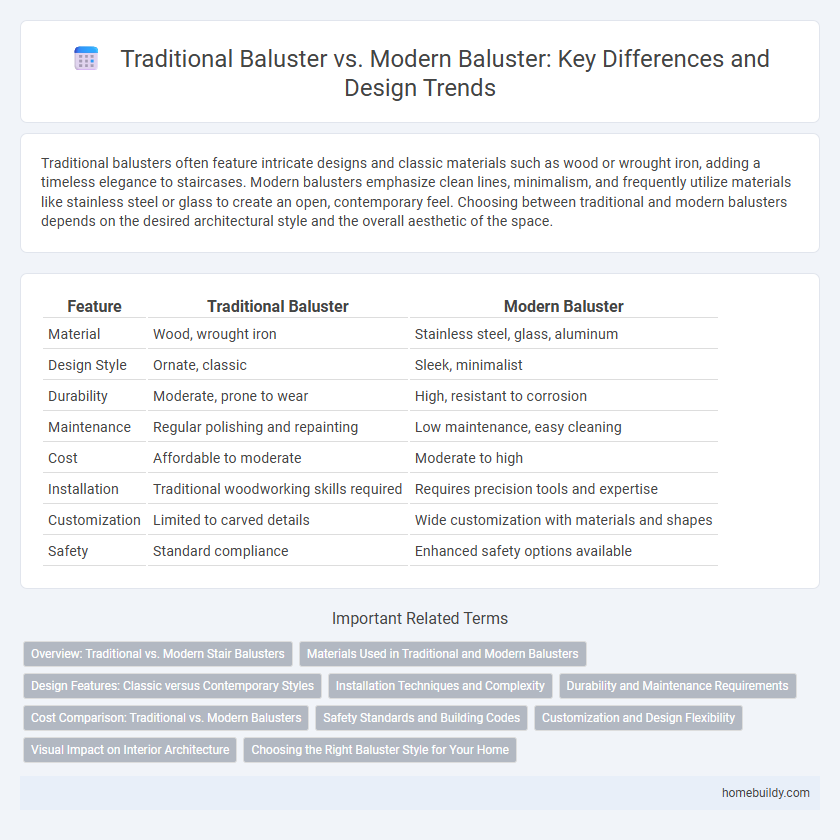Traditional balusters often feature intricate designs and classic materials such as wood or wrought iron, adding a timeless elegance to staircases. Modern balusters emphasize clean lines, minimalism, and frequently utilize materials like stainless steel or glass to create an open, contemporary feel. Choosing between traditional and modern balusters depends on the desired architectural style and the overall aesthetic of the space.
Table of Comparison
| Feature | Traditional Baluster | Modern Baluster |
|---|---|---|
| Material | Wood, wrought iron | Stainless steel, glass, aluminum |
| Design Style | Ornate, classic | Sleek, minimalist |
| Durability | Moderate, prone to wear | High, resistant to corrosion |
| Maintenance | Regular polishing and repainting | Low maintenance, easy cleaning |
| Cost | Affordable to moderate | Moderate to high |
| Installation | Traditional woodworking skills required | Requires precision tools and expertise |
| Customization | Limited to carved details | Wide customization with materials and shapes |
| Safety | Standard compliance | Enhanced safety options available |
Overview: Traditional vs. Modern Stair Balusters
Traditional stair balusters often feature intricate designs, crafted from wood or wrought iron, emphasizing classic aesthetics and ornamental details that complement historic or vintage interiors. Modern stair balusters prioritize clean lines and minimalist styles, commonly utilizing materials like stainless steel, glass, or sleek metals to create an open, contemporary look. The choice between traditional and modern balusters impacts the overall architectural tone, balancing decorative craftsmanship against streamlined functionality.
Materials Used in Traditional and Modern Balusters
Traditional balusters commonly use materials like wood, wrought iron, and stone, valued for their classic aesthetics and craftsmanship. Modern balusters often incorporate sleek materials such as stainless steel, glass, and aluminum, offering durability and minimalist design appeal. The choice of material directly influences the baluster's style, maintenance requirements, and overall stairway atmosphere.
Design Features: Classic versus Contemporary Styles
Traditional balusters showcase intricate craftsmanship with ornate details such as turned spindles and carved patterns, often made from wood or wrought iron to enhance classic architectural aesthetics. Modern balusters emphasize minimalist design, featuring clean lines, geometric shapes, and materials like stainless steel or glass to create an open, sleek look. The contrast between the two lies in traditional styles prioritizing decorative complexity, while contemporary balusters focus on simplicity and functional elegance.
Installation Techniques and Complexity
Traditional stair balusters often require more intricate installation techniques, involving precise hand-cutting, mortise and tenon joints, and alignment to maintain classic architectural details. Modern balusters typically use streamlined installation methods such as pre-drilled holes or bracket systems, reducing both time and complexity for quicker assembly. The difference in complexity impacts labor costs and suitability for DIY projects, with modern balusters favoring efficiency and traditional styles emphasizing craftsmanship.
Durability and Maintenance Requirements
Traditional balusters, typically made from solid wood or wrought iron, offer classic durability but require regular maintenance such as sanding, staining, or rust prevention to avoid wear and deterioration. Modern balusters often utilize materials like stainless steel, aluminum, or composite polymers, which provide enhanced resistance to weathering, corrosion, and require minimal upkeep over time. The low-maintenance properties of modern balusters make them ideal for both indoor and outdoor stair applications, ensuring long-lasting performance with less effort.
Cost Comparison: Traditional vs. Modern Balusters
Traditional balusters, often made from wood or wrought iron, typically have lower upfront costs due to readily available materials and simpler manufacturing processes. Modern balusters, crafted from materials like stainless steel, glass, or aluminum, usually involve higher initial expenses but offer enhanced durability and lower maintenance over time. When evaluating long-term investment, modern balusters can provide better value despite the higher purchase price, thanks to their longevity and resistance to wear.
Safety Standards and Building Codes
Traditional balusters often feature classic wood or wrought iron designs that meet established safety standards such as the International Building Code (IBC) spacing requirements, typically limiting gaps to 4 inches to prevent child entrapment. Modern balusters incorporate materials like stainless steel or tempered glass, combining aesthetic innovation with compliance to updated building codes that emphasize structural integrity and impact resistance. Both styles adhere to critical safety regulations, but modern balusters frequently integrate enhanced durability and fire-retardant properties.
Customization and Design Flexibility
Traditional stair balusters often feature classic shapes and fixed materials like wood or wrought iron, limiting customization options to standard sizes and finishes. Modern balusters offer enhanced design flexibility through diverse materials such as stainless steel, glass, and composite, enabling personalized styles, colors, and dimensions to suit unique architectural themes. Advanced manufacturing techniques allow custom balusters with intricate patterns and innovative forms that integrate seamlessly into contemporary stair designs.
Visual Impact on Interior Architecture
Traditional balusters often feature intricate carvings and classic profiles that create a sense of elegance and craftsmanship, enhancing the timeless appeal of interior architecture. Modern balusters utilize sleek, minimalistic designs with materials such as stainless steel or glass, delivering a clean and contemporary visual impact that emphasizes openness and light. The choice between traditional and modern balusters significantly influences the overall aesthetic, from ornate and warm atmospheres to streamlined and airy environments.
Choosing the Right Baluster Style for Your Home
Traditional balusters feature intricate designs and classic materials like wrought iron or wood, enhancing homes with a timeless, elegant appeal. Modern balusters offer sleek lines and contemporary materials such as stainless steel or glass, fitting minimalist and open-concept interiors. Selecting the right baluster style depends on your home's architectural theme, desired aesthetic, and maintenance preferences.
traditional baluster vs modern baluster Infographic

 homebuildy.com
homebuildy.com